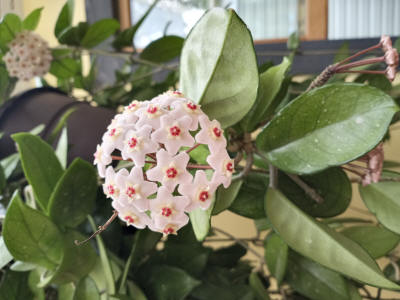 During these excruciatingly hot days, I find myself spending more time inside during the heat of the day. I turn my attention to my sunroom, containing various indoor plants, as a respite from the heat. The solarium contains an ever-useful Aloe Vera, three Kalanchoe Pinnata plants, a twenty-year old Schlumbergera (Christmas cactus) and many old faithfuls such as the Spathiphyllums (Peace Lily) given to me when my grandmother and grandfather passed. All of these plants are special, however there is one that is queen of the menagerie; a Hoya Carnosa, which belonged to my grandmother and has been in the family since 1960. The fact that this wonderfully beautiful plant lasts for decades is reason enough for an add to your collection, however that fact along with its easy-care requirements should pique the interest
of anyone who finds enjoyment in collecting indoor specimens.
During these excruciatingly hot days, I find myself spending more time inside during the heat of the day. I turn my attention to my sunroom, containing various indoor plants, as a respite from the heat. The solarium contains an ever-useful Aloe Vera, three Kalanchoe Pinnata plants, a twenty-year old Schlumbergera (Christmas cactus) and many old faithfuls such as the Spathiphyllums (Peace Lily) given to me when my grandmother and grandfather passed. All of these plants are special, however there is one that is queen of the menagerie; a Hoya Carnosa, which belonged to my grandmother and has been in the family since 1960. The fact that this wonderfully beautiful plant lasts for decades is reason enough for an add to your collection, however that fact along with its easy-care requirements should pique the interest
of anyone who finds enjoyment in collecting indoor specimens.
The Hoya Carnosa is native to Asia, Australia and the Pacific Islands and is part of the Asclepiadaceous family. It is a twining plant, with sometimes speckled, dark green, waxy leaves, which give the Hoya Carnosa its common name, Wax Plant. There are many variations of leaves contained on one plant. The waxy, ovate-shaped leaves may be speckled with a large amount of white or gray spots or they may have very few flecks upon the surface. Leaf sizes may also be varied on the same plant but generally reach a mature size of 1-3 inches wide and 3-6 inches long. The mature plant produces beautiful, aromatic flowers throughout the spring and summer. My Hoya Carnosa has been in constant bloom since early May. It blooms in phases, with the oldest growth bearing flowers first, on leafless spurs or stubs that remain intact once the flowers die. These spurs are where the plant produces flowers each year and should not be removed. The flowers
are pastel pink and velvet-like, with five petals, resembling a star shape. The small flowers bloom in clusters, sometimes reaching up to thirty in number and the sweet smell permeates the room.
When growing a Hoya Carnosa, keep in mind that it produces long, woody vines. Affix the vines to a trellis within the pot in order to give the plant a bushy appearance. You may also let it grow wild and allow it to hang or drape it across hooks from the ceiling. Keep in mind that the vines grow rapidly during spring and summer months and may reach floor length in no time if planted in a hanging basket.
As mentioned earlier, a Hoya Carnosa is an easy plant to grow and maintain due to its reasonable care requirements. It grows best in well-draining, evenly moist soil and the soil should be allowed to dry between waterings. Use a general potting mixture found at any garden supply store. The plant requires more water during the summer months and does best within a humid environment. You may mist the leaves in extremely arid environments; however, I have never found this necessary.
Hoya Carnosa does best in high light and requires sunlight in order to flower. If you find your plant does not produce flowers after two years, move it somewhere with more access to sunlight.
Place Hoya Carnosa plants where the temperature ranges between 60-75 degrees and the air is well circulated. When the plant is dormant, it can survive a low temperature of 40 degrees.
Fertilize the Hoya Carnosa monthly during its active growth period, which is generally from mid-March through September. Use an all-purpose liquid fertilizer you can add during regular watering.
Propagation of the Hoya Carnosa is relatively easy and has a high success rate. Select a length of stem that includes three to four leaf nodes and cut the stem beneath the last node. Dip the stem in rooting hormone powder and place the stem within the potting mixture contained in a small pot. Keep the soil moist and roots should develop within 1-2 weeks and flowers generally after two years. You may also root the cuttings by placing the end in water for about two weeks. Once the roots develop, plant the Hoya Carnosa in a small pot following the previous steps listed.
When selecting a planter for a Hoya Carnosa, keep in mind that they prefer to be slightly root bound. Always choose a pot that is only a few inches bigger than its current container.
My Hoya Carnosa has been living for decades and has brought enjoyment to four generations. It’s easy-care requirements allow room for error, a desirable trait to any level plant connoisseur, and it is a real showstopper when in bloom. Consider adding a Hoya Carnosa to your indoor landscape for many of its wonderful attributes and it will bring years of delight!
Read other articles on house plants